The AMD Llano Notebook Review: Competing in the Mobile Market
by Jarred Walton & Anand Lal Shimpi on June 14, 2011 12:01 AM ESTBattery Life: All Day Computing
AMD makes a point of their mobile offerings (A/C/E-series APUs) all offering “all day computing”, with a note that “all day” is defined as eight hours or more. While that’s easy to do with a gigantic battery, doing so with the typical 48/56Wh batteries in mainstream laptops is a lot more difficult. One of their test notebooks apparently manages around 10.5 hours (best-case) with a 62Wh battery, compared to 6.5 hours for a similar Core i5-2410M laptop. Without specifics on all the settings, we’ll just say that our results for “similar” laptops don’t show nearly the disparity AMD achieved, but the important point is that AMD is finally competitive in battery life.
We ran our usual series of battery life tests, with the LCDs set for ~100 nits (70% brightness for the Llano laptop). We shut off WiFi for the idle test and mute audio; the Internet test is run over WiFi and repeatedly loads four tabs of content every minute, again with audio muted; finally, the H.264 playback result is done with a set of earbuds connected and WiFi disabled. Here’s how the Llano laptop stacks up to some recently reviewed laptops—you can compare Llano with other laptops in Mobile Bench.
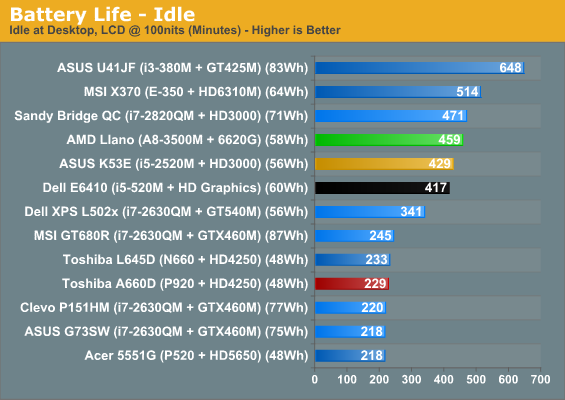

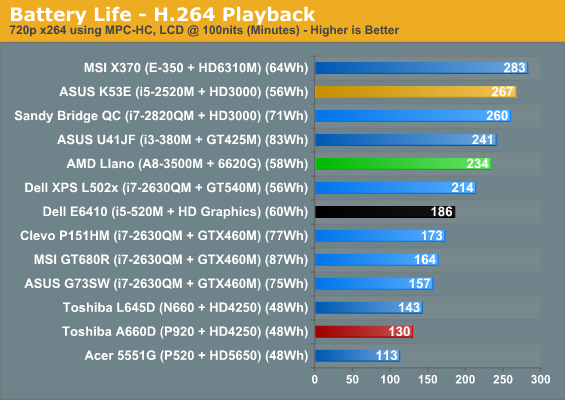
Starting with pure battery life, only three laptops consistently offer longer battery life than the Llano system: the ASUS U41JF, MSI’s X370, and the quad-core Sandy Bridge notebook. Also, the ASUS K53E boasts better battery life in the H.264 playback test, which for whatever reason is a test where SNB has proved particularly potent. Intel’s DXVA decode may be efficient, but it's also possible it's doing less work; we're running the test again with all of AMD's video enhancement features turned off. [Update: I retested with all the AMD video enhancement features disabled, and battery life didn't change, so Intel is simply more efficient at H.264 decoding with SNB.]
Back to the discussion of battery life: all three of the laptops that beat Llano have the advantage of slightly to moderately higher battery capacities, so the comparison isn’t entirely fair. Let’s level the playing field by looking at relative battery life.
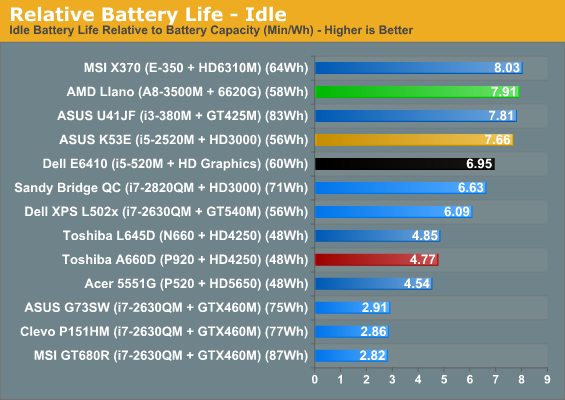
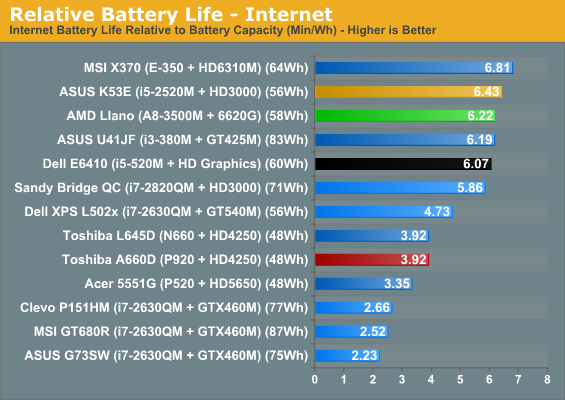
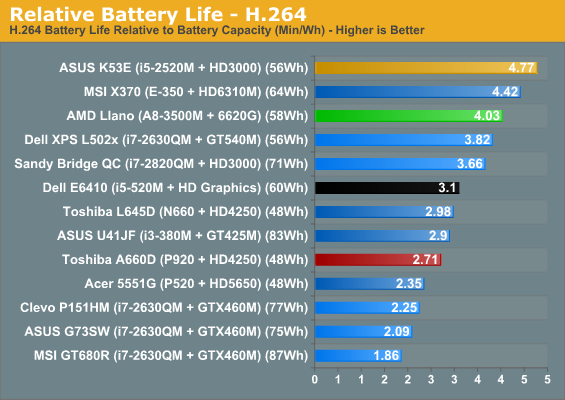
Rather amazing is that Llano actually rises to the top of the charts in the Idle test, and it’s only slightly behind the competition in the other two tests. Considering the X370 is equipped with an E-350 APU, the fact that Llano is even close is surprising. While we should note that the X370 wasn’t the most efficient of the E-350 laptops we’ve tested, we also need to point out that the 13.3” LCD is a lot closer to the 14” panel in the Llano notebook than the 11.6” panels used in the Sony YB and HP dm1z. The dual-core SNB notebook still leads in the H.264 test, and considering it has a 15.6” panel we’d say that relative battery life is very similar between the two.
We also want to talk about AMD’s claims of “all day battery life”. If we accept their definition of 8+ hours, the test laptop doesn’t actually hit that mark in our idle test. We did run the same test again at 40% LCD brightness (around 60 nits) and managed eight hours exactly, but that’s in an absolutely best-case test. For Internet surfing, which represents a more useful metric, the best way to get 8+ hours is demonstrated by ASUS’ U41JF: stuff in a higher capacity battery!
Rounding out the battery life discussion, we also tested battery life while looping 3DMark06 at native resolution (1366x768). This represents a reasonable 3D gaming scenario, and Llano still managed a reasonable 161 minutes. Considering graphics performance is a healthy step up from what Intel’s HD 3000 offers and that AMD manages double the battery life under gaming situations compared to the K53E, mobile gaming is clearly a win.
Overall, for the first time in a long time, AMD is able to offer battery life that competes with and even exceeds what Intel offers with their current mainstream offerings. There are of course a bunch of lower power Intel CPUs we could discuss, but looking at the 35W TDP parts the combination of 32nm and power gating has brought AMD back into the discussion. Even more interesting is that you should be able to get something like our test laptop for $600, possibly less, compared to dual-core SNB i5 laptops that start at $700. But then, perhaps Core i5 isn’t the best comparison for quad-core Llano, despite what AMD might like to say? Let’s move on to general performance and gaming discussions before we decide which mobile part is the “best”.










177 Comments
View All Comments
ET - Wednesday, June 15, 2011 - link
It may be impossible to know the exact speed the cores run, but it would be interesting to run a test to get some relative numbers.You can run a single threaded CPU bound program such as SuperPI, then run it again with the other three cores at 100% (for example by having another three instances of SuperPI running). Do this on AC and battery, and it might generate some interesting numbers. At the very least we'll be able to tell whether the 1.5GHz -> 2.4GHz ratio looks right.
ET - Wednesday, June 15, 2011 - link
By the way, I just read Tom's Hardware review, which was unique in that it compared to a Phenom II X4 running at 1.5GHz and 2.4GHz. It looked from these benchmarks like the A8-3500M is always performing around the 1.5GHz level of the Phenom II X4 (sometimes it's a little faster, sometimes a little slower), which suggests that Turbo Core doesn't really kick in.i_am_the_avenger - Wednesday, June 15, 2011 - link
Maybe this will cheer the AMD Fans a bitThis article did not mention some nifty features the APUs have (or maybe it did I did not read it line by line)...................................
Watch the video below from engadget:
http://www.engadget.com/2011/06/13/amds-fusion-a-s...
It shows how these APUs can smooth out shaking videos real time, even while streaming from Youtube! and it does a very good job.
Another feature is how it en-chances videos (colour etc.)
This improves general user PC experience.......... something very desirable
The video also shows how AMD wants to target general users and not work enthusiasts
Another video shows comparison between the i7-2630QM and A8-3500M while multitasking video related applications.
http://www.engadget.com/2011/03/01/amd-compares-up...
---Interesting to note that the APU Gradually increased its power consumption while i7 was like bursting to and fro, something the way turbo core acts maybe-----
I think it is work vs general performance,
Intel's great for work, when you need to finish tasks and it needs to be done quickly,
while AMD APUs give you a good over all pc and multimedia performance - you watch videos, play games, so what if the zip file extracts a minute late and the fGPU performance is great....
You may buy a i7 SNB with discreate GPU but that has a battery life hit (for same battery capacity) and also extra heat generation which requires more fans, also the extra weight..
Please don't start judging me or something....
I am getting confused myself, while intel looks great in every way except stock gaming and battery life(not that bad)... I think I don't need that much power, even if I work - my work isn't so CPU oriented that an i7 would matter, a 30 second task finishes in 20 ok but it does not matter to me..... but improved video and battery seems more useful to me
I don't think that all of us have to tax our CPUs to full potential -- a few have to, not considering them -- so even if Intel have faster processors for many it does not affect them as much.
psychobriggsy - Wednesday, June 15, 2011 - link
For all your moaning about not getting Asymmetric CrossFire to work, you didn't read the reviewers guide that says it only works in DX10 and DX11 mode, not DX9. So your Dirt2 benches for example clearly state DX9 for this test. I don't know about the other titles on that page - you say 5 of the others are DX9 titles. Do these titles have DX10 modes of operation - if so, USE THEM.Otherwise it just looks like you are trying to get the best results for the Intel Integrated Graphics.
Just put "0 - Unsupported" for DX11 tests by HD3000 like other sites have done.
ET - Wednesday, June 15, 2011 - link
The article said:"AMD told us in an email on Monday (after all of our testing was already complete) that the current ACF implementation on our test notebook and with the test drivers only works on DX10/11 games. It's not clear if this will be the intention for future ACF enabled laptops or if this is specific to our review sample. Even at our "High" settings, five of our ten titles are DX9 games (DiRT 2, L4D2, Mafia II, Mass Effect 2, and StarCraft II--lots of twos in there, I know!), so they shouldn't show any improvement...and they don't. Actually, the five DX9 games even show reduced performance relative to the dGPU, so not only does ACF not help but it hinders. That's the bad news. The only good news is that the other half of the games show moderate performance increases over the dGPU."
I agree that at least in the case of DiRT 2 that's blatantly false, since that game was one of the first to use DX11, and was given with many Radeon 58x0 cards for this reason.
JarredWalton - Friday, June 17, 2011 - link
DiRT 2 supports DX11, but it's only DX9 or DX11. We chose to standardize on DX9 for our Low/Med/High settings -- and actually, DX11 runs slower at the High settings than DX9 does (though perhaps it looks slightly better). Anyway, we do test DiRT 2 with DX11 for our "Ultra" settings, but Llano isn't fast enough to handle 1080p with 4xAA and DX11. So to be clear, I'm not saying DiRT 2 isn't DX11; I'm saying that the settings we standardized on over a year ago are not DX11.jitttaaa - Wednesday, June 15, 2011 - link
How is the notebook llano performing as good, if not better than the desktop llano?ET - Wednesday, June 15, 2011 - link
At least as far as CPU power is concerned, the desktop part is obviously faster. The benchmarks are mostly not compatible so it's hard to judge, but in Cinebench R10 the mobile Llano gets 2037 while the desktop gets 3390. I agree that for graphics it looks like the desktop part is performing worse in games, which is strange considering the GPU is working at a faster speed.Only explanation I can think of is that the faster CPU is taking too much memory bandwidth, but it doesn't make much sense since it's been said that the GPU gets priority. It's definitely something that's worth checking out with AMD.
ionave - Thursday, June 16, 2011 - link
http://www.anandtech.com/show/4448/amd-llano-deskt...On average the A8-3850 is 58% faster than the Core i5 2500K.
Boom. Delivered. You think its slow? It really isn't. The A8-3850 has about the performance of a DESKTOP i3. If you think that is bad performance, then you don't know what you are talking about. The battery life is amazing for having that kind of performance in a laptop. I'm sorry, but it totally destroys i7 and i5 platforms because of the sheer performance in that amazing battery life.
JarredWalton - Friday, June 17, 2011 - link
Let me correct that for you:On average, the A8-3850 fGPU (6550D) is 58% faster than the Core i5-2500K's HD 3000 IGP, in games running at low quality settings. It is also 29% faster than the i5-2500K with a discrete HD 5450, which is a $25 graphics card. On the other hand, the i5-2500K with an HD 5570 (a $50 GPU) is on average 66% faster than the A8-3850.
Boom. Delivered. You think that's fast? It really isn't. The 6550D has about the performance of a $35 desktop GPU. If you think that is good performance, then you don't know what you are talking about.
At least Llano is decent for laptops, but for $650 you can already get i3-2310M with a GT 520M and Optimus. Let me spell it out for you: better performance on the CPU, similar or better performance on the GPU, and a price online that's already $50 below the suggested target of the A8-3500M. Realistically, A8-3500M will need to sell for $600 to be viable, A6 for $500, and A4 for $450 or less.